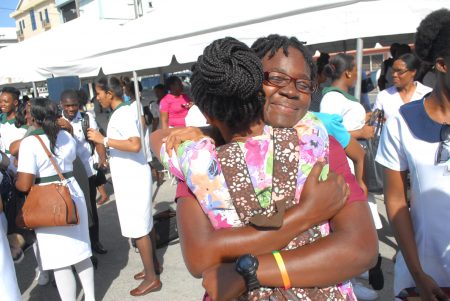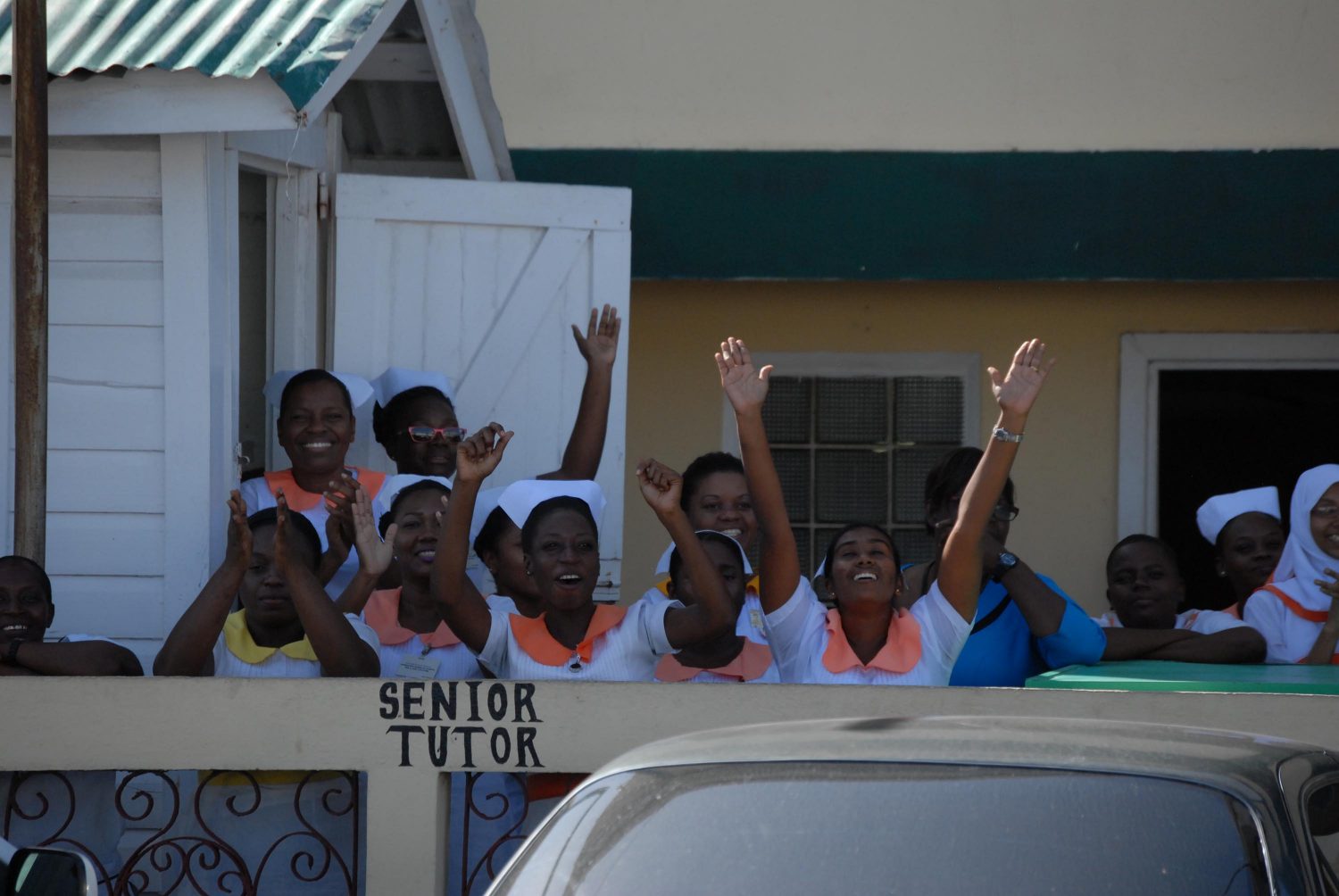The pass rate of students in the Nurses State Final exam has leapt to 97% from the dismal 7% recorded last year.
The results were announced yesterday afternoon by the Minister of Public Health Volda Lawrence during a ceremony held in the East Street parking lot, across from the Georgetown School of Nursing.
“I would just like to take this opportunity to thank God and thank all of you for giving to Guyana and to the medical profession an overall pass of 97%,” the minister announced to cheers that evolved into a standing ovation.
The screams of the soon-to-be registered nurses were challenged only by the student nurses who stood in the yard opposite, looking on at the ceremony.

One hundred percent pass rates were produced by the students of the St Joseph Mercy Hospital and the New Amsterdam School of Nursing. The Georgetown School of Nursing acquired an overall pass rate of 99.3%, the Charles Rosa School of Nursing (Linden) 98% and Texila American University 75%.
The examinations take the form of two Clinical papers, two Functional papers and the practical exams. They may be taken in parts or as a whole. It was related that a great number of the students this year were re-sitting the exams.
The improved results came with hard work and collaboration, Mandy La Fleur noted. La Fleur, who worked as a consultant in the efforts, yesterday presented the strategies developed to address the gaps that existed in the nursing programme.
She related that consultations were held at the General Nursing Council, schools, and between health and education personnel. A diagnostic examination was done to help define the approach that would be taken.
Eventually, a remedial programme was developed, and at the Georgetown School of Nursing, at least, students were subject to daily private tutoring. “I know some students complained, but then they later voiced their satisfaction: ‘This is what we needed sister,’” La Fleur recalled.
She said that focus was placed on item analysis, presentation skills, nursing care plans and practical sessions to enhance comprehension, analysis and critical thinking.
She further related that before the exam, the papers were reviewed by members of the General Nursing Council to search and rule out ambiguous questions, and ensure that there was “concurrence” between the question stems and the marking keys.
“…Originally we had a plan but then we decided after this remedial session we were confident with the readiness of students that this can work. So we didn’t drop any educational standards, we didn’t change the number of questions, we didn’t change the standard of marking and so forth,” La Fleur stated.
According to Chief Nurse Taramattie Barker, last year, of the 59 students who sat the nursing exams in March, there was a 51% pass rate. In October of last year, 179 students sat the exam—150 for the first time—and only 7% passed. Seventeen students graduated registered nurses from the 2016 batch.
Much controversy arose out of the October, 2016 examination, as there was reportedly evidence that the papers had been leaked and students were made to re-sit the examination. They received those results in March of this year.
Barker, recounting the trends over the past few years, also related that in March, 2015, of 270 students that sat the exam, there was a 67% pass rate, while in October 2015, of the 215 that wrote, there was a 35% pass rate. 156 nurses graduated that year.
In 2014, in March and October, the pass rates were 27.3% (of 292 students) and 35% (of 215 students) respectively, with 156 nurses having graduated.
It was determined by the ministry earlier this year that poor teaching methods were to blame for the high failure rate.
Addressing deficiencies
Lawrence alluded to the challenges the ministry had encountered along the way to the achievement, and presented plans for addressing current deficiencies within the programme.
Those plans include the semesterisation of the programme as a more effective means of monitoring and evaluating the students, rather than having them “regurgitate” the information after an extended period.
Lawrence also mentioned reviewing the entry criteria for students, and ensuring that the batches are representative of the various regions.
“…We want to ensure that the batches of students at our various facilities give representation to persons across the 10 administrative regions of this country, so that the ministry can move away from transferring persons to places that they don’t want to go and they don’t feel comfortable and you don’t get 100% out of them,” she explained.
She remarked also on the need to invest in resources to improve the working conditions of tutors, and consequently, the learning environment for students, and for ensuring that the ratio of tutors to students is up to standard.
“…The Ministry of Public Health is where the buck stops, [it] must take responsibility to ensure that we have institutions across the length and breadth of Guyana—one, where the physical space of studying is not a store room; and that it is conducive to learning and teaching.”
“…Since our 2020 vision places us in a position where Guyana’s people enjoy the best of health, and so in order to do that, we have to ensure that the persons whom we are asking to groom our workforce within the health service, that they have at their disposal not antiquated teaching implements; but that they are on track and that they are teaching with 21st century implements. So we have to spend more money where it is needed. We have to ensure that we provide more opportunities than those being presently provided for their constant upgrade; because the medical sciences just keep moving, moving, moving and we cannot expect them to provide a 21st century education in a 16th century classroom,” Lawrence said, before noting that hard work brings good results.





